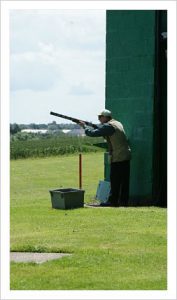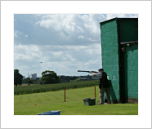English Skeet Rules & Techniques
The English Skeet clay targets are thrown from 2 traps which are situated 36.8 metres apart and at different heights. On the right hand side is the high
house and to the left is the low house. In a semi-circle starting in front of the high house and finishing in front f the low house are 7 shooting stations from which you will shoot 25 clay targets. The sequence of the clay targets are,

Stand 1 – Single High, Single Low and a pair from both traps
Stand 2 – Single High, Single Low and a pair from both traps
Stand 3 – Single High, Single Low
Stand 4 – Single High, Single Low and a pair from both traps
Stand 5 – Single High, Single Low
Stand 6 – Single High, Single Low and a pair from both traps
Stand 7 – Single High, Single Low and a pair from both traps
The eagle eyed amongst you will have seen that this only adds up to 24 targets. You are given an optional target which is either used as a repeat of the 1st target you miss or if you hit every target you can have a low or high bird on stand 7 to make your 25 target round.
All targets fly over a centre peg at the same speed and height on each occasions. This is of course unless the wind starts to move them around or give them extra speed.
The Clay Pigeon Shooting Association (CPSA) are the organisation that set the rules for English Skeet and for many they set the level for the shooters. At the time of publishing the classifications are,
Classification % Targets Hit

AA = 96.31% and above
A = 96.30% – 93.70%
B = 93.69% – 90.57%
C = 90.56% and below
English Skeet does not have AAA or D classifications. You can find the up to date listings on the CPSA website www.cpsa.co.uk/classifications. The category of the English Skeet for the CPSA is ESK this is normally found on fixtures and scores listings. The full rules for CPSA English Skeet competitions can be found in the booklet “CPSA General Rules & Techniques” which can be downloaded at www.cpsa.co.uk/userfiles/file/53938_CPSA_Rule_Book_AW_2015_V2.pdf .
At most clubs practice is a casual affair not forgetting safety of course but the sequence of shooters is normally organised beforehand and the same sequence is followed throughout the round. On stand 1 if you wish you can ask to see a high and low house bird so you can gauge your shooting/kill point. You must stand within the shooting stand which is normally a concrete pad with a coloured edge. You will then shoot all of your single and pair targets in one visit. It is important to point out

that unlike some disciplined you will not have a cage to stop the swing of you gun so it is even more important to ensure you do not point you gun anywhere but into the range loaded or not. You should also be aware of where your fellow shooters are.
When taking your shot you should try to hit the clay target over or near the centre point as not only will this mean that you have made your next target easier to hit but you should get a nice clean shot as the target will not have started to dive down. Many Sporting and Olympic Skeet shooters like to shoot from the gun down position but there are no rules as to whether you should shoot with the gun up (in the shoulder) or
whether you should shoot gun down. You should shoot how you want to and the way you get your best results. This subject has been long debated and will probably continue into the midst of time.
The best advice I have been given is “enjoy yourself and the rest will fall into place”.
